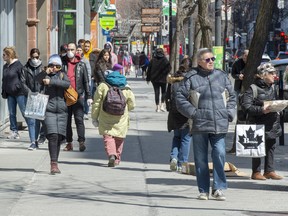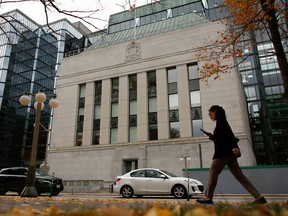‘You are comparing oranges and apples’ says Statistics Canada’s Laurent Martel
Article content
A CIBC Capital Markets Inc. report released last month suggested there are about a million more non-permanent residents in Canada than the official number, 925,000, that is widely quoted and used for planning purposes by various government authorities.
If ignored, the “undercounting” could hurt Canada’s housing and labour policies, said economist Benjamin Tal, who wrote the Aug. 30 report, Counting heads in Canada — a conundrum.
Advertisement 2
Article content
Article content
In response, Statistics Canada, the government agency that keeps track of the population count, said it stood by its numbers and that it hasn’t missed counting such a significant portion of the population.
The CIBC report, which was released days after the government revealed it was thinking about putting a cap on international students to help tackle the country’s housing crisis, garnered plenty of attention and raised questions such as: Are the “missing” million making it difficult for authorities to plan its housing and labour policies? Does Canada need to change the way it counts its population?
Who are these non-permanent residents?
Non-permanent residents include foreigners who either have a work or study permit in Canada or someone who has claimed refugee status. Family members of these persons are also included in this category unless they are already Canadian citizens, landed immigrants or permanent residents. People who enter Canada on a visitor visa are not included in this category.
As of 2021, about 28.5 per cent of Canada’s non-permanent residents were born in India and 10.5 per cent in China.
Article content
Advertisement 3
Article content
They play an important role in Canada’s economy, according to Statistics Canada, since they fill critical labour shortages in key sectors, participate in Canada’s post-secondary education system and contribute to the economy as consumers.
These residents are counted as part of Canada’s population.
How does Statistics Canada keep track?
The government agency counts the country’s population in two ways. The first is through the census, last published in 2021, which indicated there were about 925,000 non-permanent residents in Canada. The census count takes place once every five years with households answering questionnaires.
Statistics Canada also provides quarterly and annual estimates of population growth. These estimates are based on post-census coverage studies of a representative sample of people to determine how many individuals were missed or counted more than once.
The 250,000 difference
According to Tal, Statistics Canada’s estimate of non-permanent residents in 2021 was 1.17 million, which indicates a difference of about 250,000 people when compared to the census.
Advertisement 4
Article content
Laurent Martel, director at the Centre for Demography at Statistics Canada, said it’s normal for the estimates to be higher than the census, and that it isn’t an issue. He said it wouldn’t be right to compare the census with the estimate since they are different data sources.
“If you are subtracting a number taken from one source to a number taken from another source, that doesn’t work,” he said. “You cannot do that because you are comparing oranges and apples.”
Martel said the census has a “lot of characteristics,” but the demographic estimates don’t. For example, the census provides details on education, religion, Indigenous status and other aspects. It also provides “really reliable data” at a local area level. The demographic estimate, though, doesn’t tell you much except for basic information such as age, gender and sex.
He added that in 2022, Canada had a net increase of about 600,000 non-permanent residents based on the demographic estimate program.
The overstayers
In addition to the 250,000 difference between the two population counts, CIBC said there were at least 750,000 non-permanent residents who overstayed in Canada between 2017 and 2022 and that Statistics Canada’s tally has yet to reflect these numbers.
Advertisement 5
Article content
The agency’s current system assumes that temporary resident visa holders leave the country 30 days after the expiry of their visa. The agency refers to this as an interruption period.
However, CIBC said there is a huge group of people who continue to stay in the country while applying for work visas, extension of resident visas and permanent visas.
These residents are accounted for once their permit to stay is renewed, but they are not counted — after the 30-day period — until their application is approved by the government.
As such, the CIBC report looked at the gap between the renewal applications submitted from Canada and the number of approvals between 2017 and 2022 to come up with the 750,000 number. The report doesn’t indicate how many people left the country during this period.
This is where Statistics Canada’s Martel’s views don’t seem to be in sync with that of CIBC.
He said it is true that some non-permanent residents in Canada are staying longer, but Statistics Canada validates its demographic estimate by comparing it with different indicators, such as food consumption or activity in the labour market.
Advertisement 6
Article content
“We see a consistency between all those indicators,” Martel said. “This consistency would not be there if we missed a significant portion of the population, whatever this population is. That’s why I am confident in our numbers. There are reasons to believe that there’s no strong underestimation of the demographic estimates that we produce.”
To make its numbers more transparent, Statistics Canada will be publishing new data tables on non-permanent residents from Sept. 27 onward. The tables will include new interruption period rules, more details on non-permanent residents, such as their estimated numbers and permit types, as well as other “improvements.” The new approach was previously planned and not in response to the CIBC report.
CIBC economist Tal on Aug. 31 welcomed the changes when he heard about them.
“We are blessed with one of the best statistical agencies in the world. We are heavy users of Stats Canada’s data,” he said at the time. “The note was not aimed to criticize, but rather to point to some issues that need to be looked at.”
Infrastructure pressure
Advertisement 7
Article content
Bank of Nova Scotia analyst Rebekah Young said there should be an urgency in addressing data challenges regarding population estimates, but that it would be a “stretch” to blame overstayers for the housing crisis or for putting pressure on other infrastructure.
-

‘Missing’ million people not reason for strained housing, infrastructure
-

Ottawa needs to be careful with placing caps on international students
-

Are new immigrants warning people off Canada?
“Few, if any, jurisdictions have effectively planned for well-channelled immigration targets, let alone non-permanent categories,” she said. “Undocumented non-permanent residents also would not have access to basic services like health and education so are unlikely pressure points in these systems. They would also not be purchasing homes.”
Young said there is an opportunity cost in economic terms since non-permanent residents are not able to formally participate in the labour market and these numbers are looking “increasingly large.”
• Email: nkarim@postmedia.com
Bookmark our website and support our journalism: Don’t miss the business news you need to know — add financialpost.com to your bookmarks and sign up for our newsletters here.
Article content
Has Canada actually undercounted its population by a million?
2023-09-15 15:06:44






Comments
Postmedia is committed to maintaining a lively but civil forum for discussion and encourage all readers to share their views on our articles. Comments may take up to an hour for moderation before appearing on the site. We ask you to keep your comments relevant and respectful. We have enabled email notifications—you will now receive an email if you receive a reply to your comment, there is an update to a comment thread you follow or if a user you follow comments. Visit our Community Guidelines for more information and details on how to adjust your email settings.
Join the Conversation